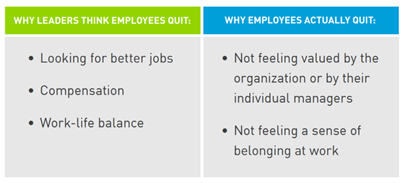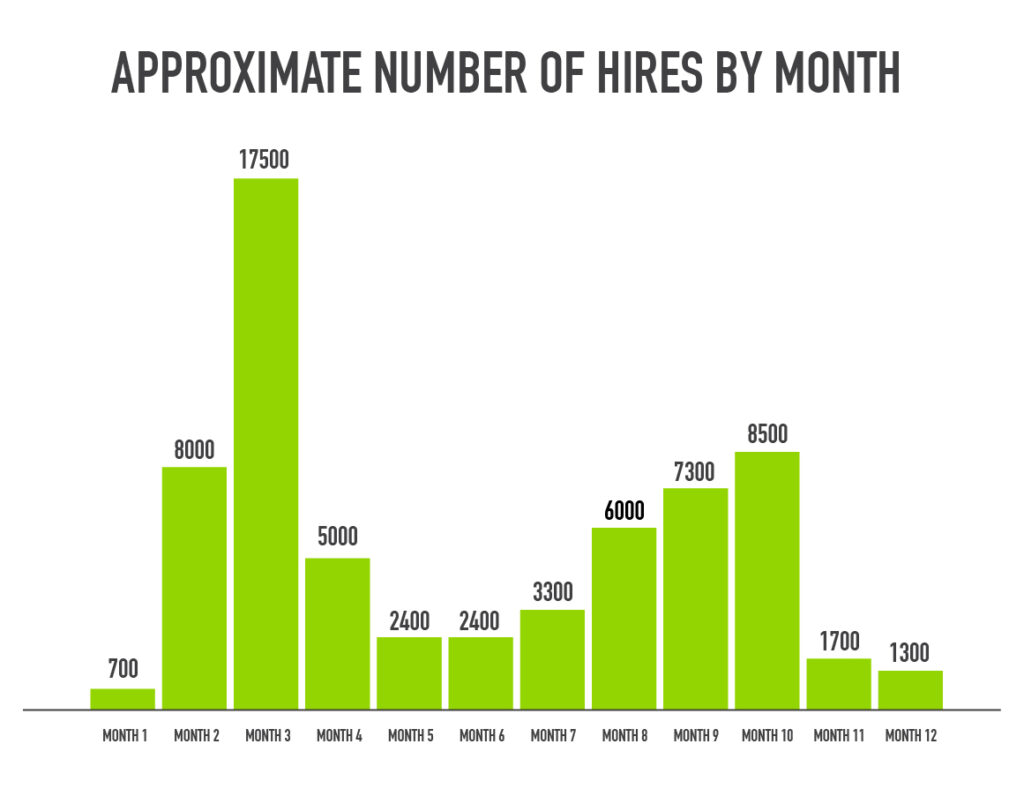Recruitment touches every employee, team and department within your business. If you’re considering recruitment process outsourcing (RPO), there will be many people in your organisation who will experience the benefits. But it also means these folks must adjust to new processes and approaches. We all know change can be hard for any organisation, so it’s important to engage various stakeholders early on to get everyone on the same page.
Human resources (HR), procurement, the C-suite and hiring managers will all have different pain points, concerns and desired outcomes. No matter where you sit in the organisation, understanding the challenges of each stakeholder can help you demonstrate how talent acquisition solutions from an RPO partner can help individuals across the organisation achieve their business goals. As a result, these stakeholders will be more “bought in” and open to changing their behaviours to make RPO successful.
In these conversation guides, we’ll help you understand recruitment challenges from the perspective of each stakeholder. Plus, you’ll get a list of questions to ask in order to gather information for your business case and tips on how to speak each stakeholder about the value of RPO.
👉 Want to learn more about RPO? Check out our guide.
RPO in HR
What Matters to HR
Whether the talent acquisition function sits under Human Resources (HR) or is a separate department, HR is a crucial stakeholder for any RPO program. Strategically, HR is particularly concerned with ensuring the organisation has the talent it needs to meet business objectives, and that it is set up to meet these needs into the future. From an operational point of view, HR supports hiring managers and current (and future) staff through the entire employee lifecycle. They strive to meet the standards of hiring managers and the C-suite by balancing organisational productivity and employee needs, creating a flourishing company culture and obtaining the best talent to support ongoing success.
Top Concerns:
- Quality of hire
- Employee retention
- Workforce planning
- Employer branding
- Diversity, equity & inclusion (DE&I)
How to Talk to HR about RPO
When speaking to HR, it’s important to present RPO as solving critical business challenges and not just as outsourcing your recruitment function, which can sometimes trigger emotions and anxieties about potential redundancies within the in-house recruitment team. It may be helpful to discuss how RPO could complement or augment the existing in-house recruitment resources to expand scope, provide specialised expertise and alleviate workload. Emphasise the ability of an RPO to scale up and down as hiring needs change and to tackle parts of the recruitment process that would allow the HR team focus on other priorities.
Show examples of how an RPO partner can act as a trusted advisor who can optimise your talent acquisition program through process, technology and employer branding improvements. RPO providers have access to market insights to help HR and talent acquisition leaders make workforce decisions and strategic plans for the future. Plus, with DE&I expertise honed across many clients, an RPO partner understands how to source, engage and hire candidates from underrepresented groups.
Questions to Ask HR to Gain Buy-in for RPO
Strategic Focus
- Are there roles that are crucial to your organization’s objectives that you’re struggling to hire for now? How do you see this changing over the next couple of years?
- What are the retention rates for hires made in the last 12 months?
- What are your DE&I goals, and how does talent acquisition fit in?
- Are your employer brand and talent attraction methods effective for engaging the right talent profiles in all regions? What feedback are you getting from hiring managers?
Tactical Focus
- Are you using any third-party agencies for permanent hires? What are the associated costs? Are they meeting Service Level Agreements (SLAs)?
- Is the talent acquisition team the main point of contact for these agencies, or are hiring managers engaging them?
- What technology are you using for recruitment? What’s missing from your current recruitment tech stack?
Operational Focus
- How many in-house recruiters do you have right now?
- What is the recruitment process? Are there stages where you’re seeing high drop-out rates?
- Are you measuring the candidate experience (i.e., candidate NPS) or asking for candidate feedback? What are you hearing back?
- What are your key and/or recurring operational issues, and what is causing them?

RPO and Procurement
What Matters to Procurement
Procurement leaders look at external spend and evaluate and select vendors that partner with the business to drive results. They are often champions for RPO as they welcome the cost saving benefits. As with any purchase for the business, they’re interested in benefits like flexibility, cost reduction, risk mitigation and tangible results against organisational goals.
Procurement will likely have set processes and policies for selecting a talent acquisition partner, so it’s best to engage them early so you understand what they require during the selection process. Treat them as a valued advisor, and they’ll be happy to support you with requirements definition, process efficiencies and contract negotiations. Bring them in too late, and they could feel more like a barrier than an ally.
Top Concerns
- Cost per vacancy
- Agency spend
- Process efficiencies and added value
- Risk mitigation
How to Talk to Procurement About RPO
When discussing RPO with procurement, emphasise the economies of scale that can be gained by an RPO partner’s ability to ramp up and down. Procurement professionals will be wary of getting locked into a contract that’s too rigid to account for unanticipated changes in the business environment, so stress the flexibility within the potential RPO partnership.
If your organisation is leveraging multiple staffing agencies, procurement may be frustrated with the disparate methods for obtaining talent and will be motivated to reduce the reliance on third-party agencies to gain control of costs. Share information about how RPO can help you consolidate recruitment under a single partnership, reduce staffing agency usage and make costs more predictable. They may also be interested to hear about a potential RPO provider’s supplier management capabilities as part of an integrated total workforce solution.
👉 Ready, Set, RPO: What to Expect in a New RPO Partnership.
Questions to Ask Procurement to Create Buy-in for RPO
Strategic Focus
- What is the current annual external spend on talent acquisition?
- How many third-party agencies are being used for permanent hires? Who is managing these relationships?
- What issues are created by using multiple agencies?
- What resources would be needed to support an RPO approach long-term?
Tactical Focus
- When it comes to deciding on an RPO solution, what do you see as the qualifying criteria? What is the winning criteria?
- What stages and timescale do you anticipate for a selection process like this?
- Are you committed to any contract termination timescale with existing suppliers?
Operational Focus
- What data do you need to collect internally for the procurement process?
- How should you initiate discussions with providers in the market?
Securing Executive Buy-in for RPO
What Matters to the C-Suite
The CEO and other members of the C-suite are chiefly concerned with ensuring the organisation has the talent it needs to keep a competitive edge. In the midst of economic uncertainty, companies are struggling to navigate changing employee expectations and hire the talent they need. It’s crucial for the CEO to feel confident that the organisation can quickly fill vacancies and grow with high quality talent in order to maximise productivity, hit revenue targets and retain customers.
Top Concerns
- Speed to hire
- Candidate experience
- Candidate quality
- Employer branding
- Cost per vacancy
How to Talk the C-Suite About RPO
When speaking to the CEO about an RPO solution, highlight how the long-term partnership allows for a holistic approach to creating a strategic talent acquisition program that fuels business initiatives. They will also be excited by the labour market insights that RPO providers offer, which is not part of an engagement with a staffing agency. This data will help with strategic planning so the C-suite can make informed decisions about geographic expansion, new products or services or other business transformations.
In addition, leading RPO partners offer talent advisory services, including employer branding. This consulting engagement creates a differentiated employer value proposition to help your organisation become an employer of choice for all your talent audiences.
Questions to Ask to Gain Executive Buy-in for RPO
Strategic Focus
- Do you have talent gaps that are impacting productivity and/or revenue?
- Does your talent acquisition strategy reflect and boost your employer brand?
- Does the current recruitment program support business continuity and succession at all levels?
- Are there business changes coming that could impact recruitment (i.e., merger or acquisition, reorganisation, new location, new product or service, etc.)? Do you feel prepared for these changes with the current talent acquisition approach?
Operational Focus
- What talent acquisition metrics do you have access to? What would you like to see?
- Does your visibility into recruitment program vary by region?
- Do you have good insight into what roles your competitors are hiring for?

Hiring Manager Buy-in for RPO
What Matters to Hiring Managers
The relationship between hiring managers and recruiters can vary significantly. In some cases, it can be strained, especially when the talent acquisition program is not meeting the hiring managers expectations. In others, there is a strong relationship, though this does not necessarily mean that business needs are being met. Often there’s a mismatch in perceptions—80% of recruiters say they have a high understanding of the jobs they’re trying to fill while 61% of hiring managers disagree.
We recommend speaking to hiring managers in departments where a lot of hiring is needed, like call centres with seasonal fluctuations, or teams where skills are particularly hard to find, like software development teams. This will give you a sense of the current state and the amount of time and effort hiring managers are investing in the recruitment process.
Top Concerns
- Filling positions quickly with a consistent process
- Candidate quality
- Spending less time on recruiting activities
- Trust in the process and recruiters they work with
- Control over budget
How to Talk to Hiring Managers About RPO
Hiring managers will want to know how the RPO team manages the recruitment process and how they can reduce the hiring manager’s time investment through interview scheduling, assessment execution and even offer management. Emphasise the RPO partner’s focus on providing quality feedback to both candidates and hiring managers for a great all-around experience.
Another benefit of RPO for hiring managers is reducing time-to-fill through talent pooling. Leading RPO teams create pools of qualified candidates so they’re not starting from scratch every time you open a new requisition or need to backfill a role. In addition, proactive outreach means you can engage with passive candidates who may never have considered your organisation, widening your access to talent.
Questions to Ask Hiring Managers to Create Buy-in for RPO
Strategic Focus
- How much time are you putting into hiring activities?
- What are the key areas of need or challenge?
- What are you spending directly on recruitment (i.e., advertising or agency spend/budget you control)?
- Are you attracting the right candidates in terms of both skills/experience and cultural fit?
- How would you rate the quality of candidates being presented by in-house recruiters and/or agencies?
Tactical Focus
- Are you engaged with third-party recruitment agencies? Are they meeting their SLAs?
- What kinds of agencies are you working with? What are their strengths?
- What other recruitment approaches have been working for you (e.g., LinkedIn, events)?
Operational Focus
- What is your offer acceptance rate for each job type?
- Are there any roles you get too many responses for?
- Are there any elements of the process that are not efficient or effective for you or candidates?
Paving the Way for Recruitment Process Outsourcing
Although obtaining data and information for your RPO business case is an important reason to have these conversations, your key aim should be to gain buy-in for RPO and build trust, and to develop a joint-working approach. Hearing stakeholders’ stories, as well as understanding their motivations and what might be blocking them from supporting change, will foster a culture of collaboration and set your RPO program up for success.
One of our experts would be happy to provide information about RPO, more tips on creating buy-in or help building your business case! Let’s chat!





